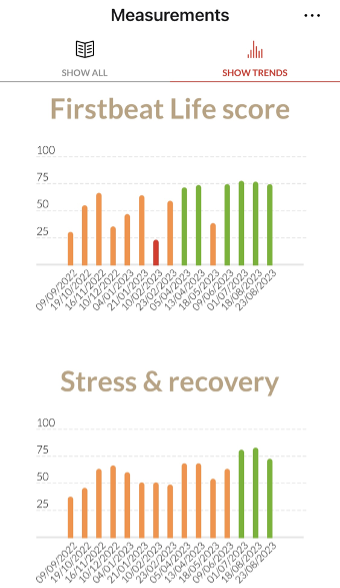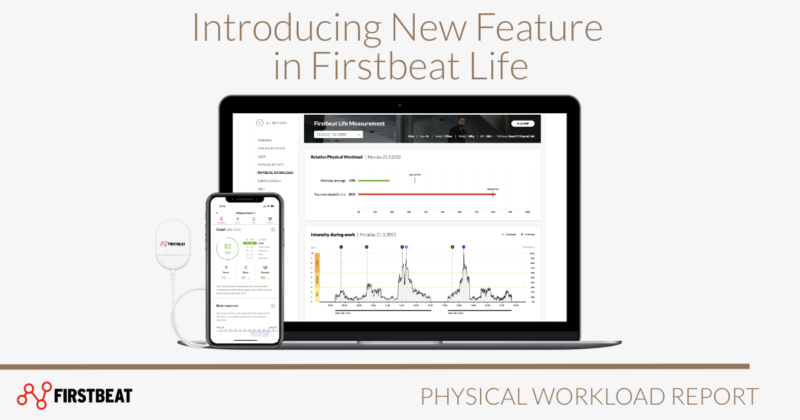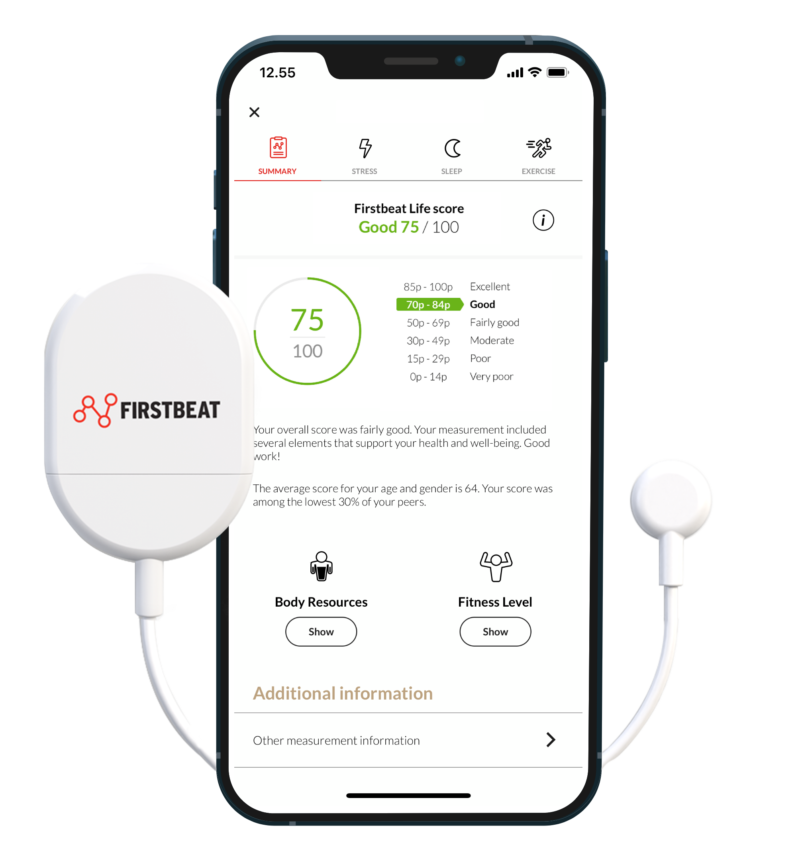
To wear or not to wear…? Sensible use of wearable devices is an important consideration for coaches who want to utilize data to add depth to their programs and motivate clients to make lifestyle or behavioral changes. But how can we utilize wearable data in such a way that it boosts the client’s motivation and helps improve their health or fitness – instead of becoming another stress factor?
In this blog, I will discuss the Firstbeat Life service from the viewpoint of how you and your clients can take full advantage of it, in a meaningful way, to boost motivation and learning.
Personalized Lifestyle Insights from Data
Firstbeat Life provides high-quality data and personalized insights for the individual and the coach – and is designed to be worn periodically (for example, once per month) for a detailed check-in into the client’s lifestyle and progress.
The app provides unique information about the individual’s stress, recovery, sleep, and exercise status, but with everything that is going on in people’s lives, it’s easy to “get too busy” to put the device on. Even one measurement can provide valuable information, but the essence of the service is to support behavioral change by trying different things and identifying habits that work for you. For this to happen, a clearly outlined plan,regular support, and “gentle reminders” from the coach can make a big difference, ensuring the device does not end up collecting dust on a shelf after the first measurement…
Encourage Your Client to Start Testing
Regardless of what the focus of your coaching program or intervention is (weight loss, better nutrition, getting fit, stress management, mindfulness, mental well-being, balanced lifestyle…), you can easily add a series of Firstbeat Life measurements to support it.
Encourage the client to do some testing – and help them understand that when they are doing this, they can shift focus away from the numbers and trends. The result might take a hit during certain experiments, but in my experience, some of the most valuable learnings come from these trials.
It’s important not to worry if the trend is not ever-improving – that’s part of the natural learning process. By gaining a deeper understanding of the various drivers and drainers of your clients’ well-being, you can help them improve and feel better in the long run.
Some ideas to keep your client engaged:
- Test different things (during a 3-6-month Firstbeat Life project):
- Different exercise sessions and the timing of exercise –> effect on sleep
- Effect of aerobic exercise on fitness level (e.g. baseline test + re-test after a couple of months of doing regular aerobic exercise).
- Activities that support or disturb sleep (alcohol / caffeine / bedtime routine / meditation / reading versus TV / timing and intensity of evening exercise…)
- Workday structure to lower stress and promote recovery (try different breaks / silent work hours with no multitasking / 5-10min break between Teams meetings)
- Effect of eating rhythm or evening eating habits on daytime recovery and sleep
- Start and end the client’s Firstbeat Life period with a “standardized” 3-day measurement:
- “Regular life”; no major experimentation (e.g. 2 workdays + 1 day-off) to verify the impact and effectiveness of your coaching program or intervention.
- In between, encourage the client to freely test and experiment. 24-hour measurements can be a good way to do this; it’s easier to commit to 24 hours than to several days and nights of measuring.
- Measure on different days to see how the client’s body reacts to them, such as a very stressful day, a relaxing weekend day and night (with and without alcohol, if relevant), a rest day from exercise versus a very intensive exercise day
Comparing the results from different days and discussing the findings with your client can help open their eyes to the effect of different choices and behaviors, with focus on realistic actions. This can help take the focus away from the result itself, especially if it’s not very good. Even small positives or interesting insights can work wonders with a client’s motivation.

Fig. 1 – The Firstbeat Life trend view reflects the ups and downs of life. An ever-increasing trend is not realistic, especially when trying different things and learning how one’s body responds to different things.

Fig. 1. Client wanted to see how evening exercise affects recovery – and saw that recovery was delayed by several hours. This is physiologically a normal finding and usually no cause for concern. Understanding this helps you and the client build a balanced exercise plan that includes enough easier exercise and recovery.
Does Data Help When the Result Looks Bad – And the Client is Struggling?
Sometimes the client has a healthy lifestyle and does “all the right things” but the physiological result looks bad. They might have a lot of health or other challenges in their life, and the result can reflect this by showing poor recovery that is not caused by poor lifestyle choices. Can data provide added value in this situation – or should you focus on other things for a while?
My take is that in most cases, data can provide added value even in difficult situations, as long as it’s interpreted sensitively, and even small positives are noticed. The coach’s role is very important, pointing out, for example, how the stress level drops when taking a break or trying to relax, or how there is some daytime recovery, even if sleep looks red, or highlighting the value of long enough sleep. Focus needs to be on small acts and observations – on things the client can influence – and less on the Firstbeat Life scores that might not be sensitive to the client’s situation.
There are also situations when the best thing might be to deal with whatever is going on and forget measurements for a while. The app can prompt the client to see a doctor if the result is consistently very poor around recovery; this is to rule out an illness or health-related explanation for the poor result. The coach should encourage the client to seek additional help if they are not the expert themselves. You can still set some goals and support the client in their journey – and perhaps check back in with a measurement a bit later.
Help Your Client Learn What Works and What Does Not
Stressful days will happen now and then, but if we get too accustomed to high stress and poor recovery, we no longer see how it impacts our well-being. As coaches, we can help our clients understand this and find meaningful ways to utilize data to gain deeper insights into their unique physiology. With accurate data and sensitive, customized coaching, we can have real impact on our clients’ lives and help them build healthier, more sustainable routines.
Accurate physiological data allows you to understand your clients’ wellness status and identify potential health risks and make better coaching decisions. It helps you to deepen and lengthen your client relationships. Learn more about Firstbeat Life.
If you liked this article, you should subscribe to our newsletter.
You might also be interested in

Why Good-Quality Sleep Should Be at The Heart of All Comprehensive Coaching Programs
Restorative sleep is the basis of good health and performance – it helps the body recover from stress, physical exertion, and fatigue, whereas poor-quality or insufficient sleep predisposes us to…

This Reliable and Easy Way to Test Your Clients’ Fitness Level Is a Must-have for All Fitness Coaches
Whether it’s a new client or one that you have been working with for a while, it’s essential to get a real understanding of their fitness levels – particularly cardiovascular…

Firstbeat Develops Tool to Assess Physical Workload in Physically Demanding Jobs
Expert organizations around the world are concerned about the declining trend in people’s physical fitness, from the point-of-view of performance at work. Firstbeat Technologies, a global leader in physiological analytics,…



